
Hello, everyone! Are you all ready for a tour of Istanbul? I’m your Istanbul travel guide, and as your guide, I can guarantee that every single one of you will find an activity you’re interested in.
Do you love history or architecture? Are you a nature-lover? Are you traveling just to enjoy the beautiful scenery? Do you like partying and nightlife? Are you into shopping? Do you enjoy trying different cuisines?
Even if you answered “yes” to all of these questions, you’ll be able to find your every point of interest in Istanbul.
It’s a magical city where you’ll…
- …find yourself in the middle of a fascinating history.
- …be fascinated by the architecture dating back centuries.
- …become speechless because of the marvelous scenery.
- …taste the best food in the world.
- …be able to buy authentic items, spices, etc.
- …see its other face at night and enjoy the lively atmosphere at a nightclub.
Have we given you enough reasons to visit Istanbul? Great! Read on to learn everything you need to know before packing your bags.
 Table of Contents
Table of Contents
- All About Istanbul!
- 10 Must-See Places in Istanbul
- Turkish Survival Phrases for Travelers
- Learn More with TurkishClass101!
All About Istanbul!
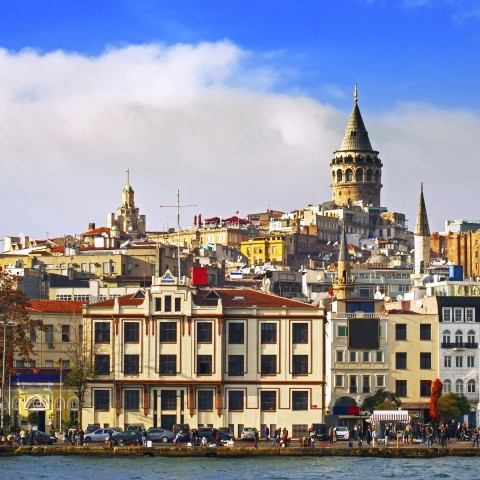
General Information
To kick off our Istanbul visit guide, here’s some general information you should know about the city before packing your bags.
- Istanbul is located in northwestern Turkey in the Marmara region.
- With 15.5 million residents, it’s the most populous city in Turkey and in all of Europe.
- It has a surface area of 2063 sq. mi (roughly 5343 sq. km).
- It’s a transcontinental city because the Bosphorus connects the Marmara Sea and the Black Sea. The Bosphorus also divides the city into two sides: European/Thracian and Asian/Anatolian.
- Istanbul is one of the oldest cities in the world. Its history goes back to about 2500 years ago. It has had many different names over the span of its history, two of which were Byzantium and Constantinople.
- It has served as the capital of four different empires: the Roman Empire between the years of 330-395, the Byzantine Empire between the years of 395-1204 and 1261-1453, the Latin Empire between 1204-1261, and finally the Ottoman Empire between 1453-1922.
- Most people think that Istanbul is still the capital of Turkey, but this is not true; Ankara is the current capital of Turkey.
- Istanbul has microclimates because of its size and various topographies. Furthermore, it’s inclusive of two different seas. It has oceanic and humid subtropical climates in the north part of the city and on the Bosphorus coast. It has Mediterranean climate in the south part of the city and on the Marmara Sea.
- While talking about climate, I can hear you asking, “What is the best time to visit Istanbul?” Perfect question. The best time to visit Istanbul is from March to May or from September to November, because the weather conditions are milder in those months.
- Istanbul is the center of trade and industry in the country due to its strategic location. It’s at an intersection of land and sea routes, which definitely keeps the trade and industry alive. Istanbul is the leading city of Turkey not only economically, but also historically and culturally.
- Istanbul has the highest number of English-speaking people in Turkey. You won’t have any communication problems in most hotels, restaurants, or shops. Places like Sultanahmet, Spice Bazaar, and Grand Bazaar have guides who speak English (and a few other languages).
Istanbul Travel Tips
Here are some essential tips on how to visit Istanbul—and how to prepare beforehand—for the best possible experience.
- You must have a visa to visit Istanbul. It’s not a complicated process; you can apply for an e-visa.
- Make sure to have your passport with you at all times.
- Turkey’s currency is the Turkish Lira. There are exchange bureaus within the city, primarily at popular touristic areas. However, in order to get into the city from the airport, you’ll need some cash. Although you won’t get the best rates at the airport, you might want to exchange a small amount there.
- If you plan to visit Istanbul in winter, you might want to bring a small umbrella with you.
- Make sure to have a camera. I know we all have smartphones that have cameras, but you might prefer a more professional one that will help you immortalize the moment.
- Last but not least, I need to answer the most commonly asked question: “Is Istanbul safe to travel to?” Yes, Istanbul is mostly safe for travelers, but there are a few areas you need to stay away from (especially at night). Also, watch out for pickpockets at places like Taksim Square, Sultanahmet, the Grand Bazaar, and the Spice Bazaar.
10 Must-See Places in Istanbul
Because there are so many unique sights and experiences in Istanbul, it can be difficult to know which places you should prioritize during your stay. In this section, we’ll introduce you to the very best places to visit in Istanbul. Let’s get to it!
1 – Hagia Sophia (Ayasofya Camii)
Hagia Sophia was built in 537 during the reign of the Roman Emperor Justinian I. He employed the talent of Greek geometers to design the place, which was meant to serve as a Christian cathedral. However, in 1453, Mehmet the Conqueror had the cathedral converted into a mosque.
This work of art was the inspiration for other mosques, including:
- The Blue Mosque
- The Suleymaniye Mosque
- The Kılıç Ali Pasha Complex
- The Rustem Pasha Mosque
It was restored a couple of times over the years.
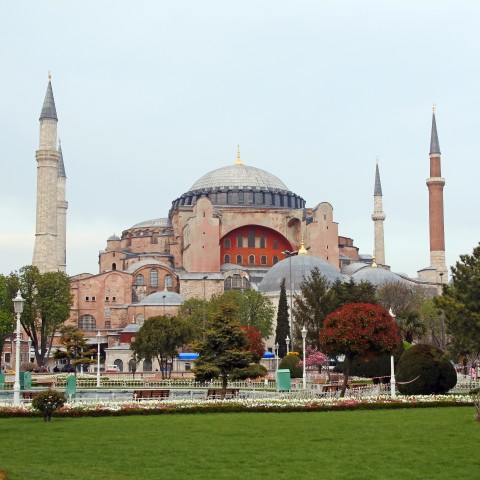
In 1931, the mosque became closed off to the public before reopening as a museum in 1935. This reopening was accomplished via the efforts of Mustafa Kemal Ataturk, the founder of the Turkish Republic.
According to the statistics provided by the Turkish Ministry of Culture and Tourism, Hagia Sophia was Turkey’s most-visited tourist place in 2015 and 2019. It was also placed on World Monuments Watch in 1996 and 1998.
In 2006, it became forbidden to use the Hagia Sophia as a place of worship, either as a mosque or a church. A small room was reserved for the Christian and Muslim staff to use as a prayer room.
There has been a lot of pressure from other world countries to convert it back to a church. Contrary to this, a new decision has very recently been made by the Council of Ministers to revert it to a mosque. It’s been said that the mosaics in the building will be preserved, but they will be covered with curtains, carpets, etc. during the prayers. It has also been declared that the doors of Hagia Sophia will always remain open to all Muslims and non-Muslims.
After this change, UNESCO will be re-evaluating the status of Hagia Sophia, which was on the World Heritage List.
2 – Topkapi Palace (Topkapı Sarayı)
Topkapi Palace is the palace where the Ottoman Empire was managed for about 400 of its 600 years. It’s also where the sultans lived and could accommodate about 4000 people at a time. Mehmet the Conqueror ordered its construction and it was built in 1478.
It was first used as a museum in 1924. When first established, it was on an area of approximately 700,000 m²; it now has an area of only 80,000 m².
It consists of hundreds of rooms and chambers, some of which are not open to visitors. A couple of the most interesting parts that are open to the public include the Ottoman Imperial Harem (where the sultan’s family would spend the day) and the treasury where the Spoonmaker’s Diamond and the Topkapi Dagger are displayed.
The palace has many amazing Islamic art pieces, hand-painted tiles, splendidly decorated rooms, and safeguarded towers. Is that all? Of course not! You’ll also find Ottoman garments, weapons, miniatures, and Islamic relics on display. Also, don’t forget to see the illuminated manuscripts (such as the Topkapi manuscript).
The palace is located within the Historic Areas of Istanbul, which was recognized by UNESCO as a World Heritage Site in 1985.
3 – Basilica Cistern (Yerebatan Sarnıcı)
This is the largest ancient cistern in Istanbul, and it’s located 490 feet (150 meters) southwest of the Hagia Sophia on the European side of Istanbul. It was built in the sixth century by the order of Byzantine Emperor Justinian I. There was previously a basilica located here, hence the name Basilica Cistern.
As one of the most fascinating museums in Istanbul, the Basilica Cistern has a ceiling supported by 336 marble columns and today has little water because it’s open to the public. There are two Medusa heads used as the bases of two columns. One head is sideways and the other one is upside-down. There’s no written record concerning these two Medusa heads.
The cistern is not only used as a museum, but also hosts many national and international events.
It was used as a location in the 1963 James Bond film From Russia with Love and was also featured in other movies. Furthermore, it was the subject of Dan Brown’s novel, Inferno.
Just a reminder: If you have asthma, it might not be suitable for you to visit this wonderful place due to the high humidity.
4 – Blue Mosque (Sultan Ahmet Camii)
The Blue Mosque was built between the years of 1609 and 1616 during the reign of Ahmet I. It’s located next to Hagia Sophia and is regarded as the last great mosque of the classical era.
It contains the tomb of Ahmet, a madrasah (a word which refers to any kind of educational institution), and a hospice. It’s called the Blue Mosque because its interior walls are decorated with hand-painted blue tiles. It has five major domes, six minarets, and eight secondary domes.
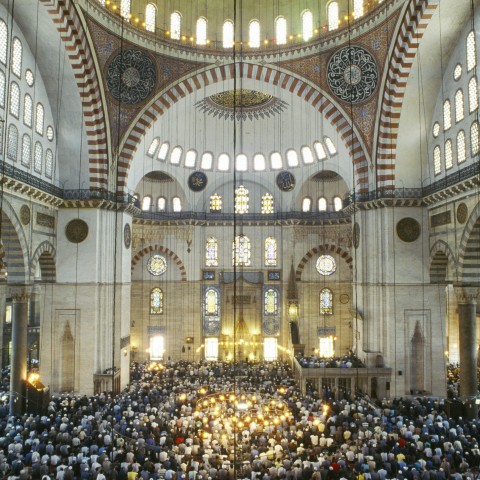
Its upper area is adorned with 20,000 hand-painted glazed ceramic tiles with sixty different tulip designs. The lower areas have 200 stained glass windows that are illuminated.
Many of the lamps inside the Blue Mosque were coated with gold and gems, but all of those items have either been taken out or stolen.
Pope Benedict XVI visited this mosque in 2006. It was considered an important event because this was only the second time in history that a pope visited an Islamic place of worship.
5 – Mosque of Suleyman the Magnificent (Süleymaniye Camii)
This mosque was ordered to be built by the Ottoman sultan Suleyman. Built at the highest end of the city to aggrandize the sultan, it was completed in 1557 by Mimar Sinan—the best engineer and architect of the time.
It has four minarets with ten galleries, representing that Suleyman the Magnificent was the tenth sultan of the Ottoman Empire.
It’s actually a complex that also has religious and cultural structures. Originally, it had the mosque, a hospital, public baths (hamam), a primary school, four Qur’an schools, a medical college, a Caravanserai, and a public kitchen where the poor people were served food. Many of these structures still exist, though the public kitchen is now a well-known restaurant and the hospital is the Turkish Army’s factory. Outside the mosque, you’ll also find the tomb of Mimar Sinan.
6 – Yedikule Fortress (Yedikule Zindanları or Yedikule Hisarı)
Yedikule Fortress means “Fortress of the Seven Towers.”
The Byzantine Emperor Theodosius wanted to welcome his visitors (kings, etc.) elegantly, so he wanted a Golden Gate to be built. His son, who inherited the throne after the death of Theodosius, had four towers built and had them combined with the Golden Gate.
After the conquest of Istanbul, three more towers were built at the order of Fatih Sultan Mehmet. Every one of these towers has a name.
Unfortunately, only some of the fortresses still exist today. There are about seventeen pieces (cannonballs, marble columns, etc.) displayed outdoors.
7 – The Galata Tower (Galata Kulesi)
Built in 1348 as Christea Turris (Tower of Christ in Latin), this is a high, cylindrical medieval stone tower that is cone-capped. It was the city’s tallest structure when it was built.
It underwent several restorations before becoming open to the public in 1960.
There are two elevators you can take to the upper levels, where there’s a restaurant and a café. The panoramic view of Istanbul and the Bosphorus from here is spectacular. There’s also a nightclub where you can watch a Turkish show and have a great time.
8 – Cruise the Bosphorus
If you would like to see more of Istanbul, you can have a cruise on the Bosphorus. Boats leave in the mornings and go toward the Black Sea. You can have your lunch at Anadolu Kavagi before walking up the hill to Yoros Castle for an amazing view. Just relax and enjoy the beauty of Istanbul!
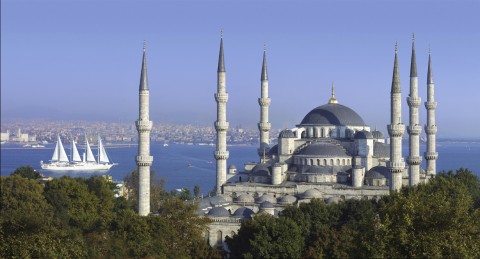
9 – Grand Bazaar (Kapalıçarşı)
The Grand Bazaar is one of the largest covered markets the world over, and one of the oldest. As a matter of fact, it’s considered the first shopping mall in the world. Today, it’s one of the most famous attractions in Istanbul. It includes 61 covered streets, more than 4000 shops, and 26,000 employees.
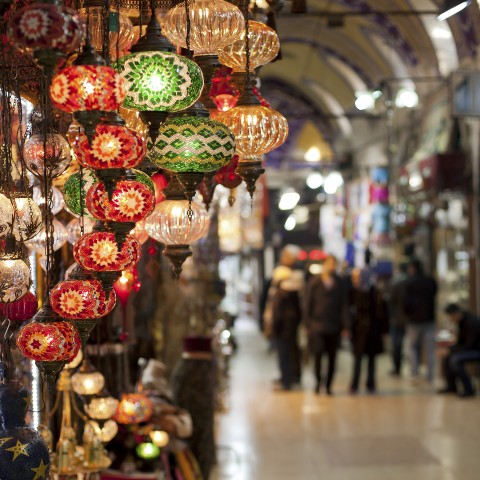
Its construction began not long after the conquest of Istanbul, in an attempt to revive the city’s economy.
For the past couple of years, the Grand Bazaar has been undergoing restoration.
10 – Spice Bazaar (Mısır Çarşısı)
The Spice Bazaar is the second most popular covered shopping area after the Grand Bazaar. You can buy Turkish delight, dried fruits, nuts, herbs, olives, and different kinds of spices. It now has a total of 85 shops in it.
There’s also a mosque called New Mosque (Yeni Camii) next to the bazaar. You might want to visit it while you’re in the area, so you can admire its tile-work and gold leaves.
Bonus
It’s impossible to talk about every point of attraction in Istanbul in just one article. But I did want to mention a few more places to visit in Istanbul if you have time:
- The Chora Church (Kariye Museum)
- Rustem Pasha Mosque
- Eyup Sultan Mosque
- Fatih Mosque
- The Hippodrome
- Dolmabahçe Palace
- Museum of Turkish and Islamic Arts
- Carpet Museum
- Pera Museum
In addition to these, you should also visit Ortakoy (a popular neighborhood) and Istiklal Street (a famous street of Istanbul).
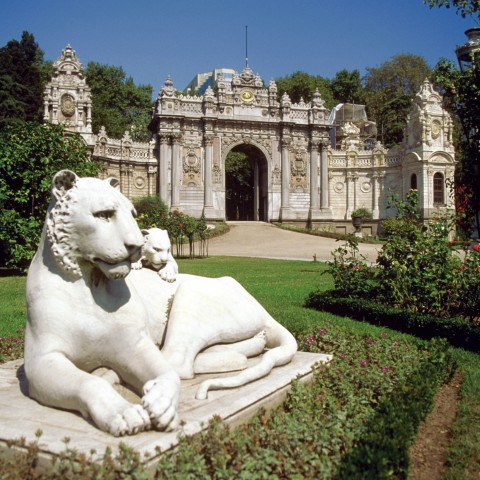
Turkish Survival Phrases for Travelers
Here are a few words and phrases that will help you communicate with locals while you visit Istanbul.
| English | Turkish |
| Hello. | Merhaba. |
| Goodbye. | Hoşçakalın. |
| Please. | Lütfen. |
| Thank you. | Teşekkür ederim. |
| Excuse me. | Afedersiniz. |
| Do you speak English? | İngilizce biliyor musunuz? |
| Can you help me? | Bana yardım edebilir misiniz? |
| I don’t understand you. | Sizi anlamıyorum. |
| Where is the restroom? | Tuvalet nerede? |
| How much is this? | Bu ne kadar? |
Learn More with TurkishClass101!
I hope this Istanbul travel guide gave you a much better idea of what to expect from this beautiful city and which spots you should definitely see. However, there’s still a lot more to know about the city, country, culture, and language!
You can get practical information on all these things by visiting TurkishClass101.com. We provide numerous audio recordings, tons of vocabulary lists, and free resources (including a Turkish-English dictionary you can refer to). In addition, our Premium PLUS members have access to MyTeacher—a feature that allows you to learn and practice with your very own personal tutor.
Interested? You can download the app for free and use it wherever you are.
By the way, which of these Istanbul locations are you most interested in seeing, and why? We look forward to hearing from you!










